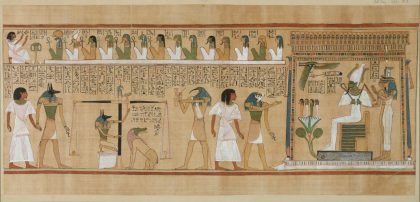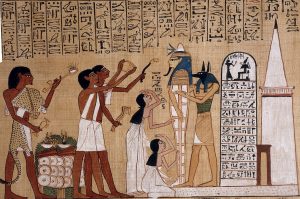Mummification and the Afterlife in Ancient Egypt
The Beliefs Behind Mummification
The ancient Egyptians believed in an afterlife, a continuation of existence in a world beyond death. This belief was rooted in their religion and mythology, where the preservation of the body was essential for the soul’s journey into the afterlife. The process of mummification was developed to ensure that the deceased’s body remained intact, allowing the soul to recognize and reunite with it in the afterlife.
The Process of Mummification
1. Preparation of the Body
- Purification: The body was first washed with water from the Nile River. Priests, dressed as the jackal-headed god Anubis, performed the purification rituals.
- Removal of Internal Organs: The internal organs were removed to prevent decay. The brain was extracted through the nose using a hooked tool, and the organs were taken out through a small incision in the left side of the body. The liver, lungs, stomach, and intestines were preserved separately in canopic jars, each guarded by one of the Four Sons of Horus.
2. Drying the Body
- Natron Salt: The body was covered and filled with natron, a natural salt, to dehydrate and preserve it. This process took about 40 days. The natron absorbed all the moisture, leaving the body dry and desiccated.
3. Wrapping the Body
- Linen Strips: The dried body was wrapped in layers of linen strips. Amulets and charms were placed between the layers to protect the deceased in the afterlife. The wrapping process was meticulous and involved numerous layers to ensure complete coverage and protection.
- Resin Coating: Each layer of linen was coated with resin to glue the layers together and create a hard, protective shell around the body.
4. Final Rituals and Placement in the Coffin
- Funerary Mask: A funerary mask, often made of gold or painted cartonnage (a type of papier-mâché), was placed over the mummy’s head to ensure the soul could recognize the body.
- Coffins and Sarcophagi: The mummy was placed in a series of coffins and nested sarcophagi, each elaborately decorated with protective symbols and inscriptions from the “Book of the Dead.”
The Journey to the Afterlife
1. The Book of the Dead
- Guide to the Afterlife: The “Book of the Dead” was a collection of spells, prayers, and incantations designed to guide the deceased through the various challenges of the afterlife. Copies of the book were often buried with the dead.
- Judgment by Osiris: Upon entering the afterlife, the deceased’s soul was judged by Osiris, the god of the afterlife. This judgment involved the “Weighing of the Heart” ceremony, where the heart of the deceased was weighed against the feather of Ma’at, the goddess of truth and justice.
2. Weighing of the Heart
- Ceremony: The heart was weighed on a scale, and if it balanced with the feather of Ma’at, the soul was deemed pure and was granted access to the afterlife. If the heart was heavier, it was devoured by Ammit, a fearsome creature with the body of a lion, the head of a crocodile, and the hindquarters of a hippopotamus.
- Confessions: The deceased would recite the “Negative Confessions,” declaring their innocence of various sins and affirming their adherence to Ma’at during their lifetime.
3. The Field of Reeds
- Paradise: Successful souls entered the Field of Reeds, a paradise that mirrored the idealized version of Egypt. Here, the deceased could live eternally, enjoying all the pleasures and comforts they had in life, without the hardships.
- Reunification with Family: In the Field of Reeds, the deceased could reunite with loved ones who had also successfully navigated the afterlife.
Conclusion
Mummification and the concept of the afterlife were central to ancient Egyptian religion and culture. The meticulous process of preserving the body and the elaborate rituals associated with death reflect the Egyptians’ deep belief in life after death and the importance of maintaining cosmic order through Ma’at. These practices not only highlight their spiritual beliefs but also their advanced knowledge of anatomy and preservation techniques.





